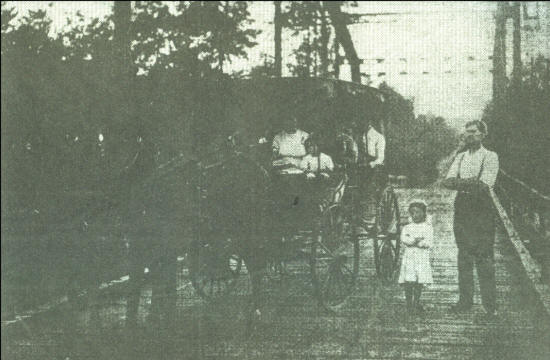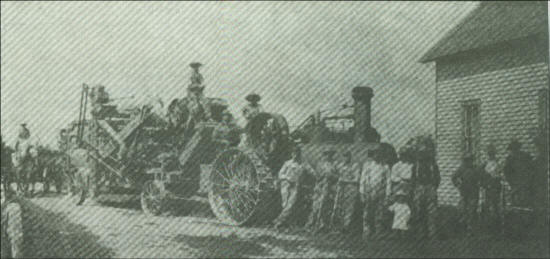|
|
|
Clark County Press, Neillsville, WI August 24, 1994, Page 28 Transcribed by Dolores (Mohr) Kenyon. Index of "Good Old Days" Articles
|
|
|
|
Clark County Press, Neillsville, WI August 24, 1994, Page 28 Transcribed by Dolores (Mohr) Kenyon. Index of "Good Old Days" Articles
|
Good Old Days
By Dee Zimmerman
Clark County’s first enterprising developers were the lumbermen, who most being transient, stayed only long enough to deplete the large timber resources, taking off to other timberland.
Next, came (were) the settlers who intended being more permanent residents, those looking for a homestead in farming or a shopkeeper, in new developing villages.
The first arrivals were usually later followed by friends or relatives who would settle nearby, eventually making up a community. People of different nationalities often were in clusters, here and there, throughout the county.
Just prior to the turn of the century, immigrants from the Baltic countries started arriving. The English, Scots and Irish pre-ceded them, coming in the 1850’s through 1880’s. Clark County’s first farming community was along Pleasant Ridge, between Granton and Neillsville – Highway 10 area. Those families were and still are referred to as the “Buffalo Tribe” because they came from Buffalo, N.Y., living there a few years after immigrating (emigrating) from England.
The Southwestern part of the county had the Bohemian-Czechoslovakian residents; Willard area had the Yugoslavian’s. Thorp’s settlers (after the turn of the century) were from Poland and toward Lublin, the Russian immigrants. People from Germany formed communities in Loyal, Neillsville and northeastern areas of the county. In many instances, they chose land with terrain that reminded them of their homeland.
The north central portion of Clark County around Withee and to the south, toward Greenwood, was largely occupied by descendants of Danish pioneers. Most were followers of the Rev. A. S. Nielsen, who had been pastor of the large congregation in Chicago. Enthusiastically preaching the “Second Coming,” he moved from Chicago to escape its coming tribulations. He became acquainted with one of the Spaulding’s, known as a family of lumbermen of Jackson and Clark Counties. Spaulding purchased many tracts of land so as to harvest the timer on it. Rev. Nielsen arranged for a gift of some of that land from Spauldings, land for a church, a pastor and a Danish colony.
Shortly after the Danish people arrived at the new area, Spaulding became bankrupt, victim of the depression of the 1890’s. His holdings were bought out by John S. Owens who was under obligation to carry out Spaulding’s promises. Followed by a period of tension in which the Danes threatened to give up the enterprise and move out. Eventually the Owens gave substantial amounts of land, and the Danes settle down to church and farms.
Excerpts from a Mr. Andersen’s diary: “Summer time we built new roads through the woods. One hot day the big horse flies bothered the horses so bad we had to stop and kill flies. In those days we were pestered by horse flies, deer flies, gnats, mosquitoes and wood ticks. Some days those pests would drive a person almost nuts.”
Recollections of the Rev. P. C. Stockholm were also recorded. Stockholm’s father heard about the founding of the Danish settlement at Withee in 1893, under the leadership of Rev. Nielsen. While in Chicago, Stockholm had heard Nielsen’s inspiring sermons and when he leaned Nielsen was to serve the people at Withee, he decided that was where he wanted to live.
In April of 1893, the first Danish settlers arrived at Withee, including Rev. Nielsen.
Some of those in Nielsen’s first congregation were Peter Frost and family, H. Hansen, and Jorgensen’s. Hansen, well-to-do, bought land, a farm, one mile south and one mile west of Withee. Jorgensen, his wife and adopted son, as well as Frost and family bought land along the Black River where the old saw mill had been. Both farms, bordering the river, had beautiful sites.
 |
This three-seated surrey was the property of the C. Dempsey livery. Several Withee relatives and neighbors rented it for the day. Standing on the old bridge that spanned Black River are Louise Hansen and J. Frost. In the surrey were Mrs. Anne Stockholm, Mrs. V. A. Hansen, Mrs. J. C. Frost, Mr. and Mrs. H. P. Hansen, Emil Hansen, Esther Frost, Edna Hansen (with an infant) and Mrs. Carl Andreasen.
Two Ammentorp brothers, related to Hansen, bought land on the Longwood road about three miles south of Withee. The two Olsen brothers purchased land along the same road.
It was during the Cleveland administration when the money crisis paralyzed all industry. There was no employment to be found. Adding to their problems was sickness. Scarlet fever struck most families, causing weeks of illness and some deaths. The doctor called on the Stockholm family every day for seven weeks to care for the ill children. Sometimes twice a day! Between the doctor’s bill and no employment, the meager savings were depleted.
When the quarantine sign was removed, Stockholm and son went in search of jobs. They hoped to purchase some land working for themselves. Word was that a saw mill was being built in Withee.
Withee had few structures amongst the pine stumps and surrounding woods. A new brick, two room, schoolhouse was under construction. Other dwellings were being built amongst the stumps.
There were woods everywhere except to the northeast. Beyond the north and east clearing, the virgin pine forest towered from 100 to 150 feet high – one of nature’s masterpieces in beauty. Directly north of Withee was the hardwood forest.
After some days of looking, Stockholm, Hansen and Christensen agreed to buy a northwest quarter of land; located a mile and a half from Withee. Hansen took the west half, Christensen and Stockholm divided the other half, lengthwise, making two long forties.
Hansen bought the old boarding house at Black River for $120, a large building. They dismantled a log cabin to set up on Hansen’s land for their home. Stockholm got some rough lumber from it to build a 10 x 12 foot shanty on his land, to live in. Soon after, a forest fire swept through woods northwest of Withee, running to and destroying some of the Stockholm’s timber.
Then came the news of Spaulding’s bankruptcy, but soon the land was taken over by the Owen Lumber Company.
W. Tufts, who had a big store in Withee, was also doing logging jobs, and when he heard Stockholm wanted work, he hired him to cook for the lumberjacks. His son was also hired and both worked very hard. Amongst their other duties was carrying all camp water from the river 50 feet away. All firewood for cooking and bunk house stoves had to be cut and carried by them. Putting in long hours eventually took its toll when father and son became sick. They returned home just before Christmas and after recuperating went on their own to cut logs and wood. Wood sold at 75 cents for a four-foot cord. In the spring they were able to make a clearing. They planted potatoes, beans and vegetables. Every little patch they had cleared was seeded with oats, grass and clover.
When it was haying time, they worked for Mads Damkjaer, who had rented the nearby Spaulding farm. Damkjaer had also taken over the agency for selling land.
The Danish church services were held in the new brick schoolhouse for two years until the new church building was erected in 1895. At that time, the Danish Folk Society was founded. A 320 tract of land had been granted to the church, at the north edge of Withee, extending one mile north.
Little by little, Stockholm’s and the others built their farmsteads – cleaning their land and finding jobs here and there, making some needed cash for purchases of staple foods and clothing. After a couple of years, Stockholm’s wife and daughters could return to live with him and his son, once again as a family. Finally he had been able to build a small house, large enough for the family. That fall, he sold some hay to purchase a cow and they felt that they were on top of the world, with their home, family and basic needs provided.
Life’s needs were certainly much simpler then, weren’t they? –but the struggle in getting to that point was tremendous for most pioneers.
 |
A threshing rig and its crew, as of 1900, on the Soren C. Pedersen farm, Withee community. The personnel were, left to right: Mads Madsen, who tended the water wagon; Lewy Ravn, sitting on the feeder; Fred Miller, owner of the rig; Nels Holm, fireman; Soren Pedersen, owner of the farm and standing by the engine; Nels Jensen; George Ravn; Jens Pedersen and daughter, Helga; Ed Bergstrom; Jens Jacobsen; Jens Beck; Rudolph Nielsen and G. Vaurning. This threshing outfit, with traction engine, was preceded in earlier time by a stationary engine, which had to be moved from place to place by horses. Prior to that, the tread mill, power furnished by horses, was used to thresh small grains.
 |
The old Paulson Saw Mill of Withee. The generous-hearted Paul A. Paulson always had a job for a man who needed it and always shelled out money for him who asked for it, if he had any left. In the end, the money didn’t always come out even, but he thought that was only a small difficulty growing from his moral obligation in caring for his neighbors. The Danes were thrifty, but Paulson was an exception, in more ways than one, as he was the only Democrat in Withee. When Woodrow Wilson became President of the United States, he appointed Paulson as post-master of Withee, which he accepted, thus ending his saw mill business.
••••••••••••
The Present is a Point just passed. – David Russel
••••••••••••••••••
It is better to have old second hand diamonds than none at all. – Mark Twain
|
© Every submission is protected by the Digital Millennium Copyright Act of 1998.
Show your appreciation of this freely provided information by not copying it to any other site without our permission.
Become a Clark County History Buff
|
|
A site created and
maintained by the Clark County History Buffs
Webmasters: Leon Konieczny, Tanya Paschke, Janet & Stan Schwarze, James W. Sternitzky,
|